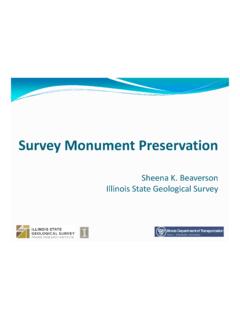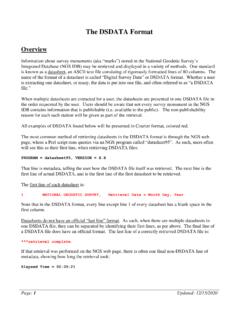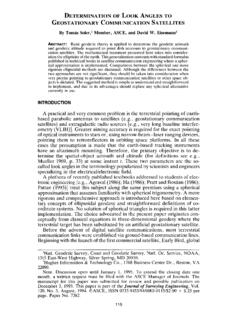Transcription of Bench Mark Reset Procedures
1 Guidelines to preserve elevation data for a soon-to-be disturbed or soon-to-be destroyed Bench markDocumented by Curtis L. SmithNational Geodetic SurveySilver Spring MD 20910 September 2010 Bench Mark Reset ProceduresUnited States Department Of CommerceNational Oceanic and Atmospheric AdministrationNational Ocean ServiceNATIONAL GEODETIC SURVEYG uidelinesBench Mark Reset Procedures1 NATIONAL GEODETIC SURVEYR elocating Vertical Control Bench Marks ..2 Setting a New Bench Mark ..2 Single Mark Level Tie (3rd Order) ..3 Observing Sequence for Optical Leveling Equipment..4 Observing Sequence for Digital Leveling Equipment ..6 When Reference Points Are Required..8 Destroyed Bench Marks ..9 Data Review and Final Adjusted Elevations.
2 9 Data Submission ..9 Bibliography..9 Attachment A. Guidelines and Procedures to Replace a Destroyed Bench Mark Along an Existing Level Line and Maintain Original Order of Accuracy ..10 Attachment B. New or Replacement Survey Monuments ..12 Concrete Monument ..12 Survey Disk Set in Bedrock or Structure..14 Survey Disk in Structure ..16 NGS 3-D Deep Driven Rod Mark ..16 Attachment C. Written Station Descriptions and Digital Photographs ..18 ContentsBench Mark Reset Procedures2 NATIONAL GEODETIC SURVEYR elocating Vertical Control Bench MarksThe purpose of these guidelines is to provide the neces-sary information to preserve elevation data for a soon-to-be disturbed or soon-to-be destroyed Bench mark1. It is impera-tive that elevation information be transferred or referenced from the original Bench mark prior to its being disturbed or destroyed.
3 Note that such destruction or disturbance remains illegal (18 USC Sec. 1858). However, that law has long been recognized as more of a deterrent than an enforceable statute. NGS understands that Bench mark resets will occur, despite the law, and therefore recognizes the need for a document to define standards for such resets. The support and cooperation of local surveyors and engineers is not only important, but essential to preserva-tion of Bench vertical control Bench mark represents a large invest- ment of resources. Since it is intended for a Bench mark to provide a continuous record of elevation changes, as well as vertical control for many local surveyors, its preservation is vital. Although Bench marks are constructed in loca-tions where they are less likely to be disturbed, many are disturbed or destroyed by: highway rebuilding and retrofit-ting; railroad maintenance; urban development; addition of buried utilities; and building construction and an existing Coast and Geodetic Survey (USC&GS), National Geodetic Survey (NGS), Geological Survey (USGS), or other agency Bench mark whose geodetic infor-mation resides in the database on the NGS Internet site (available at ) is about to be disturbed or destroyed, a representative of NGS should be contacted for further information and direction to Reset the monument.
4 Points of contact for many states are listed under the State Advisors link on the NGS Internet site (also see page 11 of this document; contact NGS directly if your state is not listed). Typical Reset Bench marks are published as 3rd Order elevations, due to the single Bench mark reference to determine elevation. Refer to Attachment A for minimum requirements to maintain the order and class of the original Bench : Verify the survey mark in question has a published vertical order listing accurate to 1st or 2nd Order through the NGS Web site before resetting the mark. Resets of existing 3rd Order vertical control or resets of marks that have already been Reset and are published as 3rd Order vertical control are not acceptable.
5 If the mark has additional other control ( , horizontal, gravity, etc.), effort should be made to transfer the other data if possible. Contact a representative of NGS, as described above, for further help and direction in perpetuating this additional are two general situations that occur when a Bench mark is to be destroyed: (1) there is time available to Reset a new monument in the vicinity before the threatened mark is destroyed, and (2) the threatened mark will be destroyed before the new mark can be set. The latter case generally occurs when the location of the new (replacement) mark is not yet suitable or available for its physical establish- ment . This is often the case when the new mark will not be set until a new bridge or culvert head wall is constructed.
6 Guidelines for both cases are presented in this The term Bench mark refers to a specific type of survey monument that is used to define the orthometric height of a Mark Reset Procedures3 NATIONAL GEODETIC SURVEYS etting a New Bench MarkUse a new NGS Bench mark disk, if available, or your agency Bench mark disk, and provide appropriate stamping. The new disk will be stamped with the same designation as the soon-to-be or already destroyed Bench mark. It will be stamped with the word Reset and the year of the Reset ; for example, a Bench mark designated M 123 Reset in the year 2006, would be stamped M 123 Reset 2006 (see Figure 1).Select a suitable site for the new Bench mark, if possible, within one setup from the Bench mark to be replaced.
7 Establish the Bench mark, as described in Attachment B of this document. Bench marks are generally set in a poured-in-place, concrete monument, in an existing stable concrete foundation (bridge abutment), in a drill hole in bedrock, or as a deep rod mark driven to refusal. NGS can provide guidance and information on other types of settings as observations between the points must satisfy 3rd Order or better accuracy standards. Sight lengths must be limited to 70 meters, for the 3rd Order standard. Where possible, the replacement mark should therefore be set within about 140 meters of the old mark. The replacement mark must be set no farther than four setups apart, , no more than 560 meters. Resets greater than four setups from the original mark will not be accepted unless they are observed following a minimum of 2nd Order, Class II proce-dures.
8 Contact an NGS representative to discuss specific site conditions and possible options. Refer to the FGCS Specifications and Procedures to Incorporate Electronic Digital/Bar-Code Leveling Systems for 3rd and higher order accuracy leveling : It is not necessary to establish the new mark at the same elevation or exact same location as the old witness post should be set within 2 meters of the relocated mark, if possible. (Occasionally the setting of a witness post can be skipped, especially if it will pose a hazard or draw unwanted attention, such as in urban areas.) Remove any witness posts for the destroyed Bench mark. A complete description of the new mark must be provided with the information identified in the Report on Location and Description of Reset Bench Mark form (downloadable from the NGS Internet site).
9 A sketch of the location is beneficial for comparison with the written description. Clear digital photographs of the disk should be provided which confirm agency information, disk size and type, and designation stamping. Legible pencil rubbings of the disk are accept-able in the event a clear digital photograph is not possible. Written station description and digital photograph guidelines are available in Attachment C. A recovery note for the old mark should be entered via the NGS On-line Mark Recovery Entry Form providing text describing the proposed destruc-tion of the old mark or by following the posted directions to report the mark as Mark Level Tie (3rd Order)An assumed elevation for the old mark can be used in the leveling since the principal concern is with the difference of elevation between the old mark and the new one.
10 It should be noted; the elevation for the newly relocated Bench mark will only be published to the nearest meter, or feet, because the absolute elevation of the Bench mark to be destroyed cannot be verified without incorporating other Bench marks into the survey, as a check. Many projects do not provide the resources required for multiple mark checks, but it is still imperative that the mark be Reset to the best precision quality level instruments and rods should be used to transfer Reset elevations to new Bench marks. Refer to Annex F of the Input Formats and Specifications of the National Geodetic Survey Data Base for a listing of Figure 1. Sample disk GEODETIC SURVEY equipment and their related codes.















